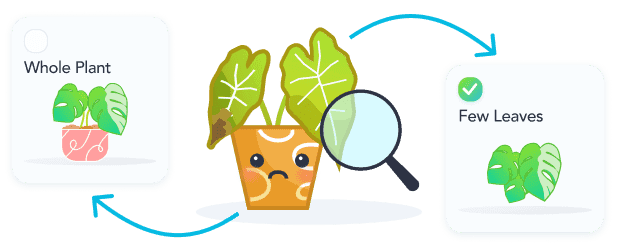Every 14d
Recommended Frequency
1 /2 cup of water
Recommended Amount
Ghost Plants only need watering once every two weeks. Make sure the soil dries out between watering, and be sure to only water around the plant, not in its center.
Every 30d
Recommended Frequency
Fertilize your Ghost Plant once a month during spring and summer using a cactus fertilizer.
Partial Shade
Recommended
Partial shade is achieved when your plant is able to receive between 3-6 hours of direct sunlight per day. These hours of sun exposure should occur during the early hours of the morning, this will relieve your plant from...
Every 1095d
Recommended Frequency
Repot your Ghost Plant every three years, or once it outgrows its pot.
Sandy Soil
Recommended Soil
Peat Soil is an acidic soil that retains a lot of moisture and slows decomposition. Due to such a high moisture retention this mix may require irrigation to help with draining. This soil type is best used when paired wit...

Shop Ghost Plant
Questions about Ghost Plant
A ghost plant, scientifically known as Graptopetalum paraguayense, is a succulent native to Mexico. It's renowned for its pale, almost translucent leaves, which give it a ghostly appearance. This low-maintenance plant th...

Toxicity of Ghost Plant

Common Pests and Diseases
Root Rot
Overwatering
To address root rot in ghost plants, first, cease watering immediately and allow the soil to dry out completely. If the plant is severely affected, remove it from its pot, trim away any black, mushy roots, and repot in fresh, well-draining soil. Consider using a pot with better drainage and adjust your watering schedule to prevent future occurrences, ensuring the soil is almost dry before watering again.
Leaf Shriveling
Underwatering
To address leaf shriveling in ghost plants due to underwatering, gradually increase watering frequency, ensuring the soil is allowed to dry out partially between waterings. Use a well-draining soil mix to prevent waterlogging. It's crucial to monitor the plant's response to changes in watering, adjusting as necessary. During hotter months, ghost plants may require more frequent watering. Always check the soil moisture level before watering to avoid overwatering.
Mealybugs Infestation
Mealybugs are small, white, soft-bodied insects that feed on the sap of the ghost plant, leading to weakened growth and potential death if not controlled.
To manage mealybugs, start by isolating the affected plant to prevent the spread to others. Use a cotton swab dipped in alcohol to dab directly onto the pests, effectively killing them without harming the plant. For larger infestations, rinse the plant under a strong stream of water to dislodge the pests, or apply insecticidal soap or neem oil, following the product's instructions carefully. Regularly inspect your plants for early signs of infestation to prevent future outbreaks.
Sunburn
Excessive direct sunlight
Ghost plants (Graptopetalum paraguayense) thrive in bright, indirect light but can suffer from sunburn if exposed to too much direct sunlight, especially during the hottest part of the day. To prevent sunburn, gradually acclimate your ghost plant to brighter conditions over several weeks. If sunburn occurs, move the plant to a location where it will receive bright, indirect light. Sunburned leaves may not recover, but the plant can still produce healthy new growth in proper lighting conditions.

Related Plants
Other Articles:
Top 10 Most Popular Roses
Mar 22, 2022
How to Care for China Roses
Mar 11, 2022
How to Care for Chinese Money Plants
May 15, 2020
How to Grow and Care for A Bird of Paradise
Apr 26, 2020
Top 10 Plants To Grow In A Terrarium
May 31, 2022
How to Grow and Care for Lucky Bamboo
Mar 29, 2022
How to Grow and Care for Corn Plants
Mar 29, 2022
How to Care for Madagascar Dragon Trees
Mar 21, 2022



